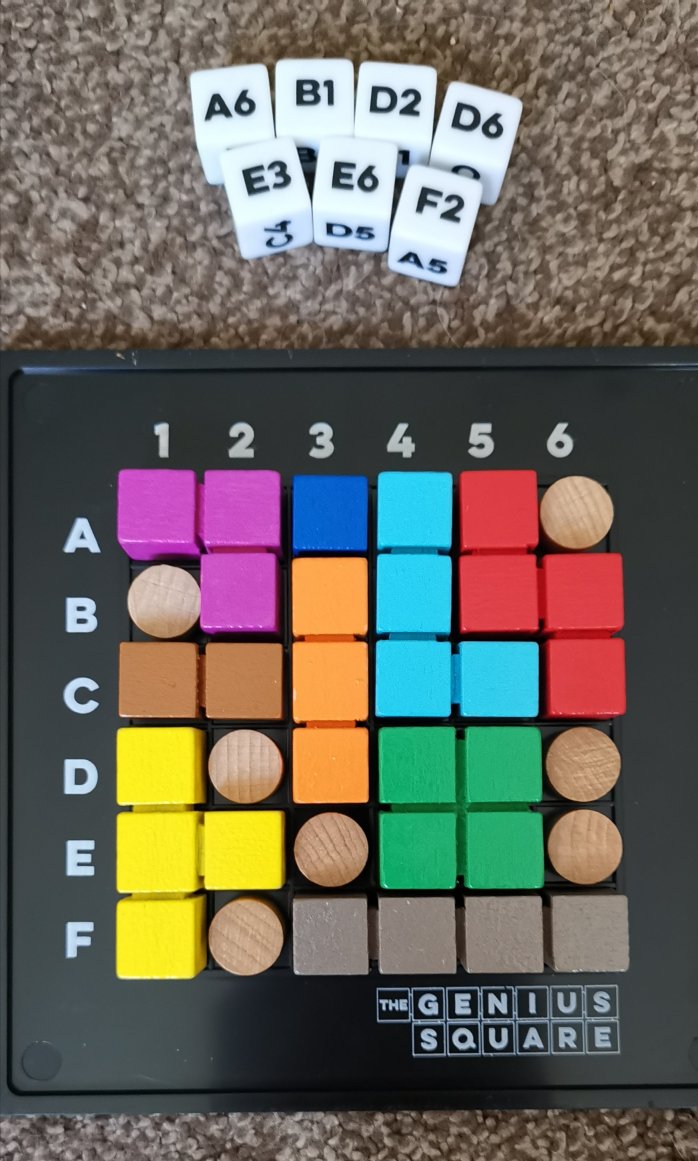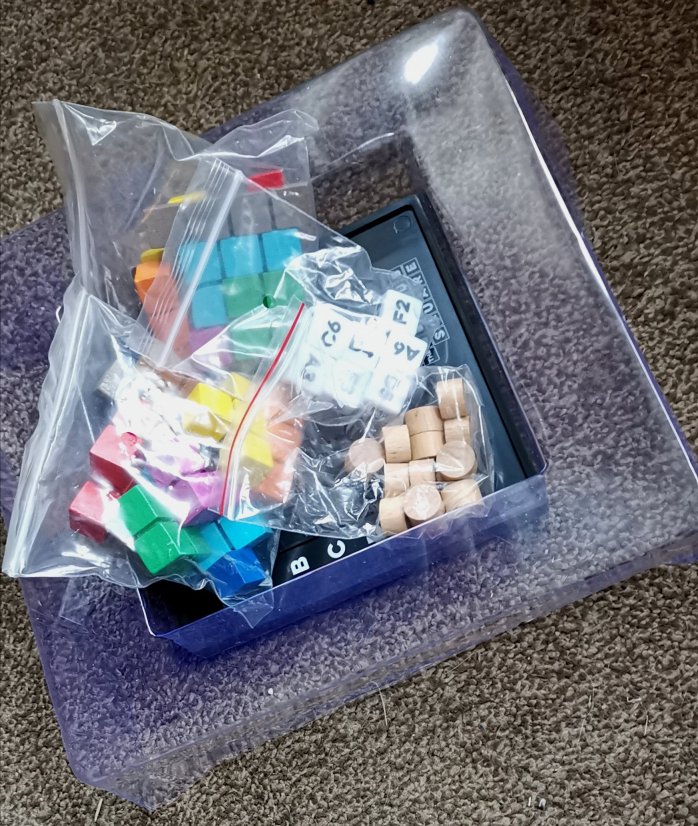ManGo's Gaming
— 'Cos Gaming Is Not Kidstuff! —
REVIEW: The Genius Square

Designer: Salim Berghiche
Publisher: The Happy Puzzle Company
1-2 players, 1-10 mins
Price: £15-20 approx.
I bought this on a whim after seeing it advertised on a YouTube video –yeh, it was one of those annoying vids you see at the beginning of something you actually want to watch that make you wait 4 secs before you can skip them– needless to say, I didn’t skip this particular ad, and was immediately grabbed by the premise, which just sounded like good fun, frankly.
Am I pleased? Definitely, and for less than £20 I think this should be on Christmas lists up and down the country as far as I’m concerned, especially if you have younger kids. I can’t directly vouch for it’s accessibility for the blind, but if it’s a colour-based blindness, then I suspect this’ll cause no issues at all: the board and pieces are all solid, chunky wood, and the dice are large and clearly legible.
The premise is simple, and it works, which is just one reason why I’m really impressed: take a 6 x 6 square, block up 7 spaces based on the roll of 7 uniquely labelled 6-sided dice, and then fill the remaining spaces on the grid using coloured, Tetris-style shaped wooden blocks. Play it solo against the clock, or race against another player instead – two boards and sets of pieces are included. Rinse and repeat: a game can take anywhere from 30 seconds to 5+ minutes, depending on how quickly you can find a solution to the square, and it’s a lot of fun, too!

Whether you’d class this as a puzzle or a game is your own lookout, but if a chap called Wolfgang Warsche can create a game called The Mind and ask players to play that using their latent psychic abilities, then The Genius Square is quite definitively a game, too, in my opinion, and much as I’ve enjoyed playing this a lot, it’s even better when playing against somebody else.
I’ve played it countless times already, both solo and with both my daughters, and it’s by turns quick, easy, and uber-competitive: getting my young girls to play any game is tantamount to a major achievement, so it was nice to turn “Let’s just play one game,” into “Let’s make it best of three”, which then turned into a “Best of 5, then,” before that turned into “Okay, the first one to win 5 games is the winner!”… And that, in a nutshell, is why I think this is a winner — stick it on that Christmas list, and don’t look back!
The box claims an apparent 62,208 different puzzles and solutions based on the spaces blocked up by the 7 ‘blocker’ pieces, and I’m not planning to test them all, but smarter minds than mine (mathematical or otherwise) might be curious to know just how those dice facings are devised, so here goes:
1). A1 C1 D1 D2 E2 F3
2). A2 B2 C2 A3 B1 B3
3). C3 D3 E3 B4 C4 D4
4). E1 F2 F2 B6 A5 A5
5). A4 B5 C6 C5 D6 F6
6). E4 F4 E5 F5 D5 E6
7). F1 F1 F1 A6 A6 A6
That last one with only two coordinates showing came as a shock to me, and it was also interesting to see that one of the dice has 2 x F2 and 2 x A5 facings on them — am guessing this is all intrinsic to the mathematical testing to ensure every combination has a viable solution, but I thought it was worth sharing all the same.
Needless to say, I really like this, and have no hesitation at all in recommending it for singles, couples, and families – it’s just great fun, frankly, and can be intense and a tad frustrating when you’re racing someone else, especially when you keep thinking you’ve got a solution and realise that actually, it doesn’t quite work!
If I do have a complaint to make, it’s about the packaging – I’m not one for politics or radical environmentalism, but in these days of climate change, plastic-based environmental issues, etc. the box for this is insultingly large, with a huge wedge of plastic used to hold the parts in the centre, all of which could arguably fit into a box half the size. Moreover, the box is a ‘sleeve’-style design, rather than just a base box and lid, which is a personal thing but nonetheless still annoying. The Happy Puzzle Company can do better than that, and this game deserves it: a more portable version would be an essential travel companion for gamers, I suspect.

Bottom-line, I like this a lot, and heartily encourage you to try it for yourself.
You can order directly from here: https://www.happypuzzle.co.uk/products/genius-square.aspx
If you mention “R A Bardy” and order using this link instead (they ask for your email address), you’ll get 15% off everything on the site – I get 15% off something else, too, when you do, but I can’t say I’ve seen much else on the site I’m that interested in, tbh:

Well, that’s interesting. I wondered how they got 62208 because 6**7=377936, but actually it’s 6**5*4*2 =62208.
I imagine the “rule” is that all tiles of the same colour must be touching, and the number of each colour varies from 2 (blue) to 4. Quite a bit of experimentation must have gone on to get these details right. Clever designer!
LikeLike
Thanks for your comment, Chris, much appreciated! I must confess to wondering where they got that particular number for the multiple permutations and different puzzle combinations available, but I was certainly not going to be the one to work it out for myself. Was quietly confident that someone had, somewhere along the line… Lol
LikeLike
What happens when you roll die 1 and 4 and get C1 for both then?
LikeLike
Thanks for your comments, Matty. Can’t say I’ve ever encountered that, but if it happens I’d probably just reroll one of those dice!
LikeLike
Your lists of die faces are simply wrong. There cannot be sqaures which appear on more than one die, or the puzzle doesn’t work.Please fix.
LikeLike
Apologies. I thought I’d already corrected this. Done now. FYI 2 of the dice faces were wrong – A5 was A4 (5), and F2 was F3 (1) — sorry!
LikeLike
5 of the dice have 6 unique cell references on but one only has 4 (A5, A5, B6, E1, F2, F2) and one only has 2 (A6, A6, A6, F1, F1, F1). Hence 6 x 6 x 6 x 6 x 6 x 4 x 2 = 62208.
Roger
LikeLike